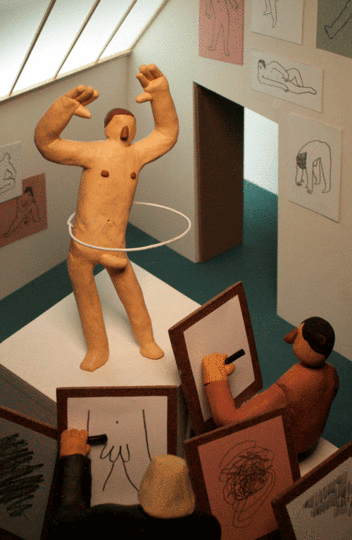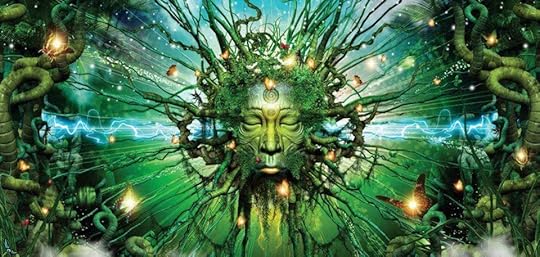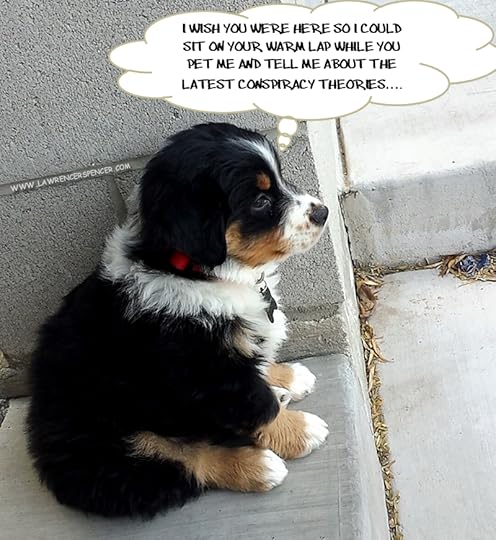Lawrence R. Spencer's Blog, page 455
June 8, 2016
PAST DEATHS
PAST DEATHS ARE THE REASON YOU DON’T REMEMBER PAST LIVES
Originally posted 2012-05-04 23:30:46. Republished by Blog Post Promoter
June 7, 2016
A LONG DAY IN DRAWING CLASS
MAXIMS OF MORTALITY
MAXIMS OF MORTALITY
“Be wary of the inherent errors that caused the Mortality of The Ones and The Creators, the omnipotent and omniscient sources of the physical universe:
∞ Omnipotence without Wisdom.
∞ Intolerance of Nothingness.
∞ The Agreement of Perpetuity.
∞ Inability to Uncreate.
∞ Becoming One’s Own Creation.
∞ Addiction to Sensation and Beauty.
∞ Valuing a creation more than a Creator.
∞ Failure to admire the Act of Creation.”
____________________________
Passage excerpted from:
The 423rd Standard Edition of The Mortality Mechanic’s Maintenance Manual
Authorized by Mortality Mechanic’s Collective Press, Chaldaron II, Galaxy Prime, Ninety-Two. Reprint Rights Reserved Upon Pain of Death by Decree of The Principle Magistrate of Mortality Maintenance, His Haughty Magnificence, Lord Flemmon-Arth-Mordus III.
________________________________________
from the book by Lawrence R. Spencer — MORTALITY MECHANICS’ MANUAL
Originally posted 2012-11-07 11:48:11. Republished by Blog Post Promoter
June 6, 2016
WISH YOU WERE HERE
THE CORE
Nikola Tesla (July 10, 1856 – January 7, 1943) was a physicist, inventor, mechanical and electrical engineer of unusual intellectual brilliance and practical achievement. He was an important contributor to the birth of commercial electricity, and is best known for his many revolutionary developments in the field of electromagnetism in the late 19th and early 20th centuries. Tesla’s patents and theoretical work formed the basis of modern alternating current (AC) electric power systems, including the polyphase system of electrical distribution and the AC motor. This work helped usher in the Second Industrial Revolution.
Tesla is most famous for conceiving the rotating magnetic field principle (1882) and then using it to invent the induction motor together with the accompanying alternating current long-distance electrical transmission system (1888). His patents and theoretical work still form the basis for modern alternating current electric power systems. He also developed numerous other electrical and mechanical devices including the fundamental principles and machinery of wireless technology, including the high frequency alternator, the Tesla coil, the blameless turbine, the spark plug, and numerous other inventions.
In addition to his work on electromagnetism and electromechanical engineering, Tesla contributed in varying degrees to the establishment of robotics, remote control, radar, and computer science, and to the expansion of ballistics, nuclear physics, and theoretical physics.
He pioneered modern electrical engineering and many of his discoveries were of groundbreaking importance. In the United States during this time, Tesla’s fame rivaled that of any other inventor or scientist in history or popular culture. Tesla demonstrated wireless energy transfer to power electronic devices as early as 1893, and aspired to intercontinental wireless transmission of industrial power in his unfinished Wardenclyffe Tower project (1901-1917) also known as the Tesla Tower, located in Long Island, New York.
Tesla was fluent in eight languages – Serbian, Czech, English, French, German, Hungarian, Italian, and Latin.
Originally posted 2014-06-08 23:03:49. Republished by Blog Post Promoter
June 5, 2016
COMPASSION HURTS
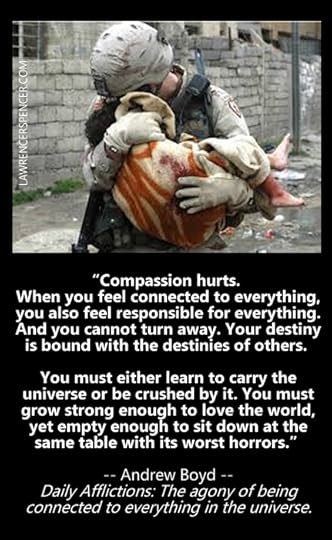 “Compassion hurts.
“Compassion hurts.
When you feel connected to everything, you also feel responsible for everything. And you cannot turn away. Your destiny is bound with the destinies of others.
You must either learn to carry the universe or be crushed by it. You must grow strong enough to love the world, yet empty enough to sit down at the same table with its worst horrors.”
— Andrew Boyd —
Daily Afflictions: The agony of being connected to everything in the universe.
READ THE BOOK: http://www.amazon.com/exec/obidos/ASIN/0393322815/qid=1006662488/ref=sr_11_0_1/104-0097384-0675166
VISIT THE WEBSITE: http://www.dailyafflictions.com/visitvoid.html
SPIRITS WATCH OVER ME
See more paintings by ANDY KEHOE on Flickr: http://www.flickr.com/photos/andykehoe/
Originally posted 2012-07-14 19:58:29. Republished by Blog Post Promoter
AESOP’S FABLE: LIFE LESSONS FROM 620 BC
AESOP’S FABLES are a collection of hundreds of short stories, usually featuring animals impersonating humans, that tell a pithy moral story. They are precise observations of human behavior made more than 2,500 years ago by a Greek writer / philosopher. Aesops lived in Greece around the same time the Buddha and Loa-Tze lived in the India and China. His moral lessons are as relevant now as they were in 620 BCE. This demonstrates the maxim that “The more things change, the more they stay the same“. Apparently, this applies even more so to human behavior and misbehavior. — Lawrence Spencer, 2012
________________________________________________________________________
Aesop (c. 620-564 BC) was a fabulist or story teller credited with a number of fables now collectively known as Aesop’s Fables. He was born a slave, and in his lifetime two different masters owned him before being granted his freedom. The slave masters were named, Xanthus and Iadmon, the latter gave him his freedom as a reward for his wit and intelligence. As a freedman he became involved in public affairs and traveled a lot—telling his fables along the way. King Croesus of Lydia was so impressed with Aesop that he offered him residency and a job at his court.
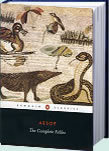 “The popularity of Aesop is also shown by the fact that Plato records that Socrates decided to versify some of his fables while he was in jail awaiting execution.” -Robert Temple
“The popularity of Aesop is also shown by the fact that Plato records that Socrates decided to versify some of his fables while he was in jail awaiting execution.” -Robert Temple
While on a mission for King Croesus to distribute a certain amount of gold to the people of Delphi in Greece, there was a misunderstanding about how much gold each person was supposed to receive. Aesop became discouraged because the Delphians did not seem appreciative enough of the gift from the King so Aesop decided to take it all back to King Croesus. On his journey back the people of Delhi, who thought he was actively cheating them and giving them a bad reputation, tracked him down. Lloyd W. Daly writes “Apprehensive of his spreading this low opinion of them on his travels, the Delphians lay a trap for Aesop. By stealth they [stashed] a golden bowl from [their] temple in his baggage; then as he starts off through Phocis, they overtake him, search his baggage, and find the bowl. Haled back to Delhi, Aesop is found guilty of sacrilege against Apollo for the theft of the bowl and is condemned to death by being hurled off a cliff.”
READ THE ON-LINE FABLES OF AESOP HERE: http://www.aesopfables.com/aesopsel.html
“We hang the petty thieves and appoint the great ones to public office.”
“United we stand, divided we fall.”
“The gods help them that help themselves.”
“The shaft of the arrow had been feathered with one of the eagle’s own plumes. We often give our enemies the means of our own destruction.”
“I will have nought to do with a man who can blow hot and cold with the same breath.”
“We would often be sorry if our wishes were gratified.”
“Never trust the advice of a man in difficulties.”
“No act of kindness, no matter how small, is ever wasted.”
Originally posted 2012-05-31 12:45:01. Republished by Blog Post Promoter
June 4, 2016
LOGIC IN THE LAND OF OZ
“WHICH IS THE WAY BACK TO KANSAS?”
“I’d give anything to get out of Oz altogether, but which is the way back to Kansas? I can’t go the way I came.”–Dorothy
“The only person who might know would be the great and wonderful Wizard of Oz himself. He lives in the Emerald City and that’s a long journey from here. Did you bring your broomstick with you?“–Glinda, the Good Witch of the North
“No, I’m afraid I didn’t.“–Dorothy
“Well then, you’ll have to walk. It’s always best to start at the beginning and all you do is follow the Yellow Brick Road.”–Glinda in ‘The Wizard of Oz’
One of the primordial questions Dorothy was trying to answer in ‘The Wizard of Oz’ was, “which is the way back to Kansas?”
Trying to figure out the answers to the mysteries of life here on planet Earth is even harder than Dorothy trying to get back to Kansas–none of us have a broomstick to ride, we don’t have a good witch to ask for directions and there is no Yellow Brick Road to follow. So, we’re stuck here having to figure it out for ourselves, logically, using the information we have in our environment.
To begin at the beginning, the Land of Oz is a type of Universe. According to Webster’s Dictionary, a universe is defined as: “an area, province or sphere, as of thought or activity, regarded as a distinct, comprehensive system or world.”
The physical reality we all share on Earth and everything throughout the surrounding space is called the Physical Universe (PU).
On the other side of reality is your own imagination, your personal perceptions, viewpoints, dreams, hopes, desires, and creations, which comprise Your Own Universe (YOU).
The Land of Oz can be considered to be a Universe dreamed up by Dorothy, as conceived in the mind of L Frank Baum, the author of the book. (It has been speculated that the author created the “Land of Oz” after glancing at his file cabinet. The two file drawers were labeled “A-N” and “O-Z”. Dorothy could just as easily have been transported by the author’s pen into the imaginary “Land of AN”.)
In the movie version of the story, Dorothy creates the Land of Oz in a dream, induced by a knock on the head, using remnants of Kansas in the physical universe mixed together with creations from her own universe–which, for Dorothy, existed over the rainbow in the Land of Oz.
Every Universe seems to be made up of its own, peculiar set of Laws. The PHYSICAL UNIVERSE, for example, is built on a set of agreed upon Laws. A few examples of these Laws are:
The Law of Motion: “For every action, there is an equal and opposite reaction.”
The Food Chain Law: “In order for one life organism to live, another life organism must die.”
The Law of Gravity: “Whatever goes up, must come down.”
The Law of Time: “Time marches on.”
Most of us take the Laws of the Physical Universe for granted because everyone seems to agree with them. However, such laws leave a lot to be desired when compared to the Laws of a Universe we might create for ourselves!
In YOUR OWN UNIVERSE you can create any set of Laws, or have no Laws at all. You can make them, change them or break them. The Laws of YOUR OWN UNIVERSE can be anything or nothing, limited only by your imagination.
In YOUR OWN UNIVERSE, everything you wish comes true, because you are the “wizard” of YOUR OWN UNIVERSE!
In Dorothy’s universe, Scarecrows and trees can talk; witches can be beautiful and fly in magic bubbles; Munchkin girls join the “Lullaby League” and Munchkin boys have a “Lollipop Guild”; horses can change their color; and, Dorothy can dye her eyes to match her gown.
Dorothy’s first awareness of the particular universe she calls the Land of Oz is the realization that she is definitely NOT in Kansas. When she opens the door to her farmhouse, which has just crash-landed in Oz, Dorothy compares her past experience in Kansas with her present experience in Munchkinland. The Technicolor flowers, a good witch in a flying bubble, all the little brightly dressed people, a yellow brick road, etc, are definitely NOT similar to anything she has ever seen in Kansas.
The Land of Oz is an example of what Earth scientists would call an anomaly. For Dorothy, the anomaly is a departure from the usual arrangement of things as compared to her past experiences. In the universe of Oz, everything is so completely different from the universe Dorothy is familiar with in Kansas that she thinks she is lost.
How do you find the way back home when you are lost?
One way is to ask someone for directions. Of course, if you’ve ever been sent on a wild goose chase by a stranger, the experience taught you that it is a good idea to be somewhat selective as to whom you ask for directions. So, how do you know who is a reliable source of directions or information?
Perhaps it would be a good idea to find out something about the person from whom you are asking directions before you act upon what they tell you. Right? (Or, is it left?)
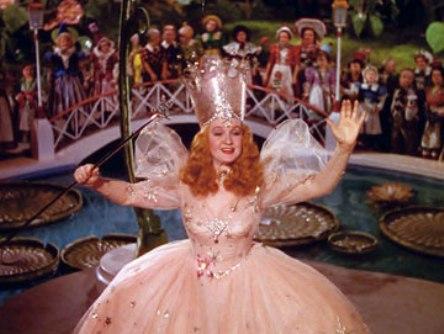
In our example, should Dorothy be asking for directions back to Kansas from the local natives, the Munchkins?
The main reason one would ask a local resident for directions is that one makes the assumption, otherwise known as an hypothesis (which is the first step in creating any scientific theory), that someone who lives in the area will be a reliable source of information and will give correct directions.
Well, in Dorothy’s case, the Munchkins have lots of familiarity with the Land of Oz, but they have no familiarity with Kansas. Fortunately for Dorothy, they are honest enough to tell her that they don’t have a clue where Kansas is, and they pass the buck to the Wizard of Oz, who they believe knows everything. And, based on their familiarity with the Yellow Brick Road and Munchkinland, they are certain that it leads to where the Great Oz lives.
Most would agree that a certainty is better than an assumption. When one has no familiarity based on personal experience or observation, it is best not to assume that one knows the correct directions. So, one asks for information from someone one believe knows–like a scientist, for example–who is supposed to be familiar with the area or subject in question.
Do the local Munchkins or local scientists of Oz give Dorothy the correct directions to help her get back to Kansas?
When Dorothy crash-landed her house in Munchkin City, the Munchkins cowered under the bushes and flowers in terror of retribution for the death of the Wicked Witch of the East from her mean, nasty, ugly sister, the Wicked Witch of the West.
Their benevolent, all-powerful protector, Glinda, the Good Witch of the North, who the Munchkins trust implicitly, is not much help in solving Dorothy’s problem, either. To begin with, Glinda does not have all the information regarding the situation, because she was not even there when Dorothy crashed her house into Munchkin City and inadvertently killed a wicked witch.
Undaunted by her lack of factual information, the first thing Glinda does after coaxing the Munchkins out from their hiding places, is to sing them a song about her assumption, or hypothesis, regarding Dorothy’s crash-landing. She sings: “Come out, come out, wherever you are, and meet the young lady who fell from a star. She fell from the sky, she fell very far, and ‘Kansas’ she says, is the name of the star.”
So, where did Glinda get the idea that Dorothy came from a star? Dorothy never said that she came from a star! But, somehow this all seems very logical to the Munchkins. Even Dorothy doesn’t object to Glinda’s false statement!
In our analogy, Glinda’s assumption that Dorothy fell from a star could be called a scientific theory. The theory proposed by the Good Witch of the North is that Kansas is a star! This theory is based on an assumption derived from an apparent anomaly as measured against her own personal experience and by information received from the Munchkins who are supposed to be a reliable source, but, who did not actually see the house crash because they were all in hiding. In truth, none of them have any familiarity with Kansas or cyclones or farm houses or dogs or little girls, either!
To complicate matters further, Glinda has to put on the appearance that she knows what she’s talking about in front of all her Munchkins followers, even though she is really just making a wild guess. After all, she has a very good job being the protector of the Munchkins, who appear to be utterly defenseless against their enemies, the Wicked Witch sisters. Anyway, Glinda is a good witch, which means she is probably really trying to help, so, they all believe her scientific theory that Dorothy has fallen from a star.
In their cute little minds, the Munchkins have accepted, without question, the logic, which underlies the assumption that is the basis of Glinda’s scientific theory:
SKY equals VERY FAR equals STAR equals KANSAS.
This kind of reasoning process could be called “Everything Logic”; i.e., Everything Equals Everything. This sort of logic might also be the definition of stupidity.
Example: If KANSAS equaled SKY equaled STAR, one could theoretically gaze up into the heavenly firmament to watch Kansas cattle grazing on the twinkling prairies in the stars above.
Unfortunately, much of what we call “science” on planet Earth is based on “Everything Logic”.
___________________________________________
— Excerpted from the book THE OZ FACTORS by Lawrence R. Spencer
Originally posted 2011-04-04 08:51:50. Republished by Blog Post Promoter
MY MONA LISA
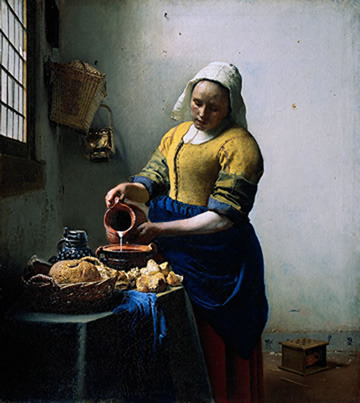
“Much like Leonardo da Vinci, I worked intermittently on this single painting over a period of many years, never satisfied that it was finished, and continually improving upon the original. This painting is my personal Mona Lisa, my daughter, Maria.
We had a live-in servant for many years, named Tanneke Everpoel, hired and paid by Maria Thins. She did all of the “heavy labor”, as it were: cooking, cleaning, washing clothes, carrying water, tending fires, and a myriad other chores, including helping with the children. However, the expense of paying her wage and room did not include standing for endless hours, day after day, while I painted this portrait! My daughter, Maria, was lovelier and much more readily accessible for the task of standing for this portrait.
It is argued, convincingly, that the immortal painting by Leonard was his own self-portrait as his own, feminine reflection. What man, or woman, regardless of sexual preference in a given lifetime, has not inhabited the flesh of ten thousand bodies, some human, many not, through a nearly infinite cascade of galaxies, stars and planets come and gone. Is not survival a nearly infinite game, in which we interchange ourselves as the players of many parts?
Leonard kept his portrait with him all his life. He never considered that it was complete or perfect. Nor did he ever intend to sell it. How could one sell a most cherished reflection of himself? It is more meaningful than one’s own body, which only disguises the inner self, the essence of spirit that animates the fragile flesh.
In fact, a body hides the reflection of the soul! How can any substance, especially that as rude and fragile as meat, reveal the inherent qualities an immortal nothingness? Indeed, it is the fundamental challenge and the most formidable task of an artist to reveal it!
The name given to this painting by others, “The Milkmaid”, is a sacrilege! It rivals the incomprehension others have for Leonardo’s personal masterpiece. Yet, how can anyone truly understand that a painting is meant to reflect the essence of an immortal being, seen through the eyes of another?
She is painted with angelic colors: blue, gold and white, in contrast to the menial nature of her station in life. From her issues, for me, the Milk and Bread of Life. Life is embodied in her and through her. Women, are the source of children, the source of energy, the source of care. There is no more vital responsibility for any being who plays the game of life, than to confront dreary daily tasks. To humbly make the daily loaf. To soak that bread, mix and soften it with milk, make it warm and feed it to a teething child. Survival is made of such things.
In those days I viewed life as idyllic. My dreams were more real than reality. All things were a possibility. Tragedy could not find me. Until it did, of course. Even when we lost a child, which we did with several, my wife, Catharina, remained resolute in her Faith. God guided us. He did what was best. We knew not why and need not question His purpose for us.
I have no such faith in predetermination. A loaf of grain, clean water and a bed was my fare. Time and a place to paint, uninterrupted, were necessities. My love, shared with wife and family, was the staple diet of my life. I assumed, as a Fool who knows not his own mortality, that they would endure, even when I was gone.”
_______________________________________
Excerpt from the book VERMEER: PORTRAITS OF A LIFETIME, by Lawrence R. Spencer
DOWNLOAD THIS BOOK FROM
http://itunes.apple.com/us/book/vermeer/id443800993?mt=11
Originally posted 2011-11-04 00:23:54. Republished by Blog Post Promoter


